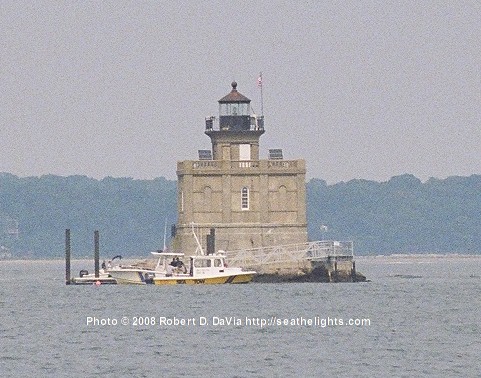HUNTINGTON HARBOR
LIGHTHOUSE

LLOYD HARBOR ~
HUNTINGTON HARBOR
LIGHTHOUSE

The first lighthouse was built in 1857 to direct the sailing ships of the day to safe haven at Lloyd Harbor The station consisted of an eleven room wooden building next to a square brick lighthouse tower. The tower was 34-foot tall from its base to its focal plane of the light. A fifth-order Fresnel lens showed a fixed white light from 48-feet above the water.
In the early 1900's, with Huntington's commercial development and ships changing from sail to propeller driven, the safety of Lloyd's Harbor became less necessary. Where the Lloyd Harbor Light served only Lloyd harbor, it was determined that a new lighthouse could be built to serve the needs of both Lloyd Harbor and Huntington Harbor.
The current Huntington Harbor Lighthouse, pictured, was completed in 1912. The reinforced concrete crib is 26-foot by 30 foot and 16-foot high. It was built on shore, then towed to the site, where it was filled with water to sink it. Riprap was then used to fill the bottom, along with concrete to fill the pockets. A concrete pier was built on top of the crib, which supports the dwelling and tower, also made of concrete. Its original lighting was provided by a fifth-order Fresnel lens, lit with kerosene, then electricity, showing a fixed red light visible for 8 nautical miles. A 1,000 pound fog bell was also installed at the site. The current light, automated in 1967, is a 300mm lens, flashing its white light every six seconds.
In 1985, the Save Huntington's Lighthouse, Inc., was formed to help save and preserve the lighthouse. The year prior, the federal government decided to demolish it, citing its condition and cost of repair. The grassroots effort led the successful bid to save the light. Since renamed the Huntington Lighthouse Preservation Society, they have been gradually restoring the building inside and out.
Unfortunately, the original Lloyd Harbor Lighthouse was not so lucky. On November 12, 1947, it was completely destroyed by fire.
First Activated November 1, 1858
Day Markings: 4 alternating black/white horizontal bands
Flash Characteristic: Counter clockwise rotation with a white flash every 7.5
seconds.
SIGN AT SECOND WINDOW
Exposure: Southeast
Tower Wall Thickness: 6'4"
Step: 52
Old Boat House (moved from Bay to the base of the original Electric Station)
1974 Fire Island Lighthouse was decommissioned due to deteriorating conditions.
A light was put on top of the Robert Moses Tower.
The Fire Island Lighthouse Preservation Society, which was formed in 1982,
successfully raised $1.3 Million dollars for restoration.
The Fire Island Lighthouse was re-lit in May 1986.
SIGN AT THIRD WINDOW
Exposure: Southeast
Tower Wall Thickness: 5'3"
Step 78
National Park Service Ranger Station
Built in 1906 as a Navy Radio Station
First community is Kismet
FOURTH WINDOW
Exposure: North
Tower Wall Thickness: 4'
Step: 104
Halfway point - 80 feet
Remnants of old Lighthouse dock.
A narrow gauge railroad ran from the dock, up to the Lighthouse and then jogged
west to the generator building.
The current flagpole is the approximate height of the first Fire island
Lighthouse.
FIFTH WINDOW
Exposure: Southwest
Tower Wall Thickness: 3'6"
Step: 130
First boardwalk leading to the ocean is approximately where Fire Island ended in
the 1820's.
Circle of bricks, west of the Boathouse, is all that remains of the 1826
Lighthouse, which was constructed at the western tip of Fire Island.
The western end of Fire Island has grown over 5 miles since the Lighthouse was
built due to Littoral drift, or a westward migration of sand due to the wind and
wave action.
HALF CIRCLE ROOM
Column, which supported the spiral stairs, is hollow in the center.
The cable inside the column was attached to a weigh, which drove the clockwork
mechanism that rotated the first order Fresnel lens.
The weight had to be wound up every four hours from sunset until sunrise each
night.
WATCHROOM
The Lighthouse Keeper spent each night in the watchroom from sunset until
sunrise.
Copper sheathing on floor was to keep oil from seeping into the wood thus
becoming a fire hazard.
Potbelly Stove, round opening in ceiling, was used to keep the oil from
congealing, not for the comfort of the Keeper.
Return to the New York State Page
Return to the: Alphabetical Listing or the Listing by States